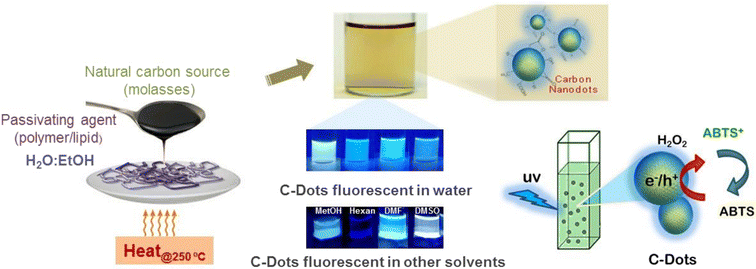An investigation into the role of macromolecules of different polarity as passivating agent on the physical,chemical and structural properties of fluorescent carbon nanodots |
| |
| Authors: | Melis?Ozge?Alas Email authorView author&#;s OrcID profile" target="_blank">Rukan?GencEmail authorView author&#;s OrcID profile |
| |
| Institution: | 1.Functional Nanomaterials Laboratory, Chemical Engineering Department, Engineering Faculty,Mersin University,Mersin,Turkey;2.Advanced Technology Research and Application Center,Mersin University,Mersin,Turkey |
| |
| Abstract: | In this study, comparative evaluation of fluorescent carbon nanodots (C-Dots) prepared using carob molasses was reported by screening various biocompatible macromolecules as passivating agent (PA). Incorporation of PAs with different molecular weight, polarity, and chemical structure was examined, and compared with the polyethylene glycol (PEG, Mn = 10 kN) passivated and pristine C-Dots. Not only the fluorescence properties but also many other features including size, crystal structure, colloidal conductivity, resistance to photobleaching, quantum yield, and UV-modulated surface interaction of them with the reactive oxygen species (ROS) as well as ROS production were investigated. Photoluminescence (PL) capacity of C-Dots was found to be associated with the number of surface alkyl groups and polymeric hydrogen bounding present on the C-Dot surface (increased number is associated with decreased PL) while surface conductivity of C-Dots in water was proportional to the PL intensity. More importantly, C-Dots with relatively poorer fluorescent were investigated in various organic solvents (hexane, methanol, acetone, ethanol, dimethylformamide (DMF), and DMSO). As happens with the fluorescent dyes, their PL intensities were significantly enhanced (even for pristine C-Dots) depending on the solvent characteristics. All of the C-Dots synthesized were further evaluated by means of UV-induced generation of ROS and inhibition of ROS by using H2O2 as model. In contrary to other carbonaceous nanomaterials, they did not show any ROS generation, on the contrary, they showed ROS scavenging activity that can be modulated by UV-irradiation (λ exc = 365 nm). PEG and alginate passivated C-Dots inhibited H2O2 activity at LC50 values below 10 mg/mL. |
| |
| Keywords: | |
| 本文献已被 SpringerLink 等数据库收录! |
|

